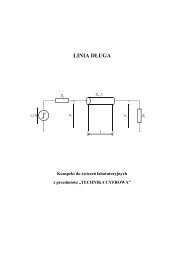9 Interlayer Exchange Interactions in Magnetic Multilayers
9 Interlayer Exchange Interactions in Magnetic Multilayers
9 Interlayer Exchange Interactions in Magnetic Multilayers
You also want an ePaper? Increase the reach of your titles
YUMPU automatically turns print PDFs into web optimized ePapers that Google loves.
336 9 <strong>Interlayer</strong> <strong>Exchange</strong> <strong>Interactions</strong> <strong>in</strong> <strong>Magnetic</strong> <strong>Multilayers</strong><br />
n(ε) ≈ cos (qD+ φA + φB) . (8)<br />
We expect, furthermore, that this effect will proportional to the amplitude of the<br />
reflections at barriers A and B, i. e., to |rArB|; f<strong>in</strong>ally, n(ε) must be proportional to<br />
the width, D, of the spacer and to the density of states per unit energy and unit width:<br />
2 dq<br />
(9)<br />
π dε<br />
which <strong>in</strong>cludes a factor of 2 for sp<strong>in</strong> degeneracy. We can also <strong>in</strong>clude the effect of<br />
higher-order <strong>in</strong>terferences, because of n round trips <strong>in</strong> the spacer; the phase shift φ<br />
is then multiplied by n and |rArB| is replaced by |rArB| n . Gather<strong>in</strong>g all the terms, we<br />
obta<strong>in</strong>:<br />
n(ε) ≈ 2D dq<br />
∞<br />
|rArB|<br />
π dε<br />
n=1<br />
n cos n (qD+ φA + φB)<br />
= 2<br />
π Im<br />
<br />
iD dq<br />
∞<br />
(rArB)<br />
dε<br />
n=1<br />
n e niqD<br />
<br />
= 2<br />
π Im<br />
<br />
i dq rArB e<br />
dε<br />
iqD<br />
<br />
(10)<br />
1 − rArB e iqD<br />
As will appear clearly below, it is more convenient to consider the <strong>in</strong>tegrated density<br />
of states:<br />
N(ε) ≡<br />
ε<br />
−∞<br />
n(ε ′ ) dε ′ . (11)<br />
The modification N(ε) of the <strong>in</strong>tegrated density of states because of electron conf<strong>in</strong>ement<br />
is:<br />
N(ε) = 2<br />
π Im<br />
∞ (rArB) n<br />
e<br />
n<br />
niqD<br />
=− 2<br />
π<br />
n=1<br />
Im ln<br />
<br />
1 − rArB e iqD<br />
A simple graphical <strong>in</strong>terpretation of the above expression can be obta<strong>in</strong>ed by not<strong>in</strong>g<br />
that Im ln(z) = Arg (z), for z complex; thus, N(ε) is given by the argument, <strong>in</strong> the<br />
complex plane, of a po<strong>in</strong>t located at an angle φ = qD + φA + φB on a circle of<br />
radius |rArB| centred <strong>in</strong> Fig. 1. This graphical construction is shown <strong>in</strong> Fig. 1.<br />
The variation of N(ε) as a function of D is shown <strong>in</strong> Fig. 2, for different values of<br />
the conf<strong>in</strong>ement strength |rArB|. For weak conf<strong>in</strong>ement (a), N(ε) varies with D <strong>in</strong><br />
s<strong>in</strong>usoidal manner. As one the conf<strong>in</strong>ement strength is <strong>in</strong>creased (b), the oscillations<br />
are distorded, because of higher-order <strong>in</strong>terferences. F<strong>in</strong>ally, for full conf<strong>in</strong>ement (c),<br />
N(ε) conta<strong>in</strong>s jumps that correspond to the appearance of bound states. We note,<br />
however, that the period, , of the oscillations of N(ε) does not depend on the<br />
conf<strong>in</strong>ement strength, but only on the wavevector q ≡ k + − k − ,i.e. = 2π/q.<br />
(12)



